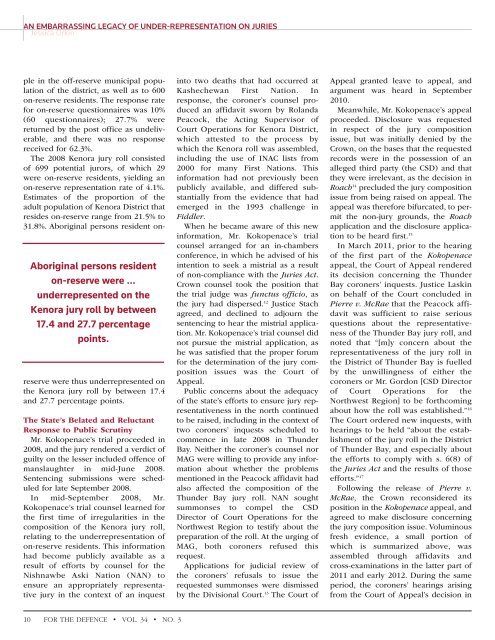FTD_Vol34_No3_web
FTD_Vol34_No3_web
FTD_Vol34_No3_web
You also want an ePaper? Increase the reach of your titles
YUMPU automatically turns print PDFs into web optimized ePapers that Google loves.
For the Defence_34-3_Layout 1 13-08-16 10:40 AM Page 10<br />
AN EMBARRASSING LEGACY OF UNDER-REPRESENTATION ON JURIES<br />
Aboriginal persons resident<br />
on-reserve were ...<br />
underrepresented on the<br />
Kenora jury roll by between<br />
17.4 and 27.7 percentage<br />
points.<br />
ple in the off-reserve municipal population<br />
of the district, as well as to 600<br />
on-reserve residents. The response rate<br />
for on-reserve questionnaires was 10%<br />
(60 questionnaires); 27.7% were<br />
returned by the post office as undeliverable,<br />
and there was no response<br />
received for 62.3%.<br />
The 2008 Kenora jury roll consisted<br />
of 699 potential jurors, of which 29<br />
were on-reserve residents, yielding an<br />
on-reserve representation rate of 4.1%.<br />
Estimates of the proportion of the<br />
adult population of Kenora District that<br />
resides on-reserve range from 21.5% to<br />
31.8%. Aboriginal persons resident onreserve<br />
were thus underrepresented on<br />
the Kenora jury roll by between 17.4<br />
and 27.7 percentage points.<br />
The State’s Belated and Reluctant<br />
Response to Public Scrutiny<br />
Mr. Kokopenace’s trial proceeded in<br />
2008, and the jury rendered a verdict of<br />
guilty on the lesser included offence of<br />
manslaughter in mid-June 2008.<br />
Sentencing submissions were scheduled<br />
for late September 2008.<br />
In mid-September 2008, Mr.<br />
Kokopenace’s trial counsel learned for<br />
the first time of irregularities in the<br />
composition of the Kenora jury roll,<br />
relating to the underrepresentation of<br />
on-reserve residents. This information<br />
had become publicly available as a<br />
result of efforts by counsel for the<br />
Nishnawbe Aski Nation (NAN) to<br />
ensure an appropriately representative<br />
jury in the context of an inquest<br />
into two deaths that had occurred at<br />
Kashechewan First Nation. In<br />
response, the coroner’s counsel produced<br />
an affidavit sworn by Rolanda<br />
Peacock, the Acting Supervisor of<br />
Court Operations for Kenora District,<br />
which attested to the process by<br />
which the Kenora roll was assembled,<br />
including the use of INAC lists from<br />
2000 for many First Nations. This<br />
information had not previously been<br />
publicly available, and differed substantially<br />
from the evidence that had<br />
emerged in the 1993 challenge in<br />
Fiddler.<br />
When he became aware of this new<br />
information, Mr. Kokopenace’s trial<br />
counsel arranged for an in-chambers<br />
conference, in which he advised of his<br />
intention to seek a mistrial as a result<br />
of non-compliance with the Juries Act.<br />
Crown counsel took the position that<br />
the trial judge was functus officio, as<br />
the jury had dispersed. 12 Justice Stach<br />
agreed, and declined to adjourn the<br />
sentencing to hear the mistrial application.<br />
Mr. Kokopenace’s trial counsel did<br />
not pursue the mistrial application, as<br />
he was satisfied that the proper forum<br />
for the determination of the jury composition<br />
issues was the Court of<br />
Appeal.<br />
Public concerns about the adequacy<br />
of the state’s efforts to ensure jury representativeness<br />
in the north continued<br />
to be raised, including in the context of<br />
two coroners’ inquests scheduled to<br />
commence in late 2008 in Thunder<br />
Bay. Neither the coroner’s counsel nor<br />
MAG were willing to provide any information<br />
about whether the problems<br />
mentioned in the Peacock affidavit had<br />
also affected the composition of the<br />
Thunder Bay jury roll. NAN sought<br />
summonses to compel the CSD<br />
Director of Court Operations for the<br />
Northwest Region to testify about the<br />
preparation of the roll. At the urging of<br />
MAG, both coroners refused this<br />
request.<br />
Applications for judicial review of<br />
the coroners’ refusals to issue the<br />
requested summonses were dismissed<br />
by the Divisional Court. 13 The Court of<br />
Appeal granted leave to appeal, and<br />
argument was heard in September<br />
2010.<br />
Meanwhile, Mr. Kokopenace’s appeal<br />
proceeded. Disclosure was requested<br />
in respect of the jury composition<br />
issue, but was initially denied by the<br />
Crown, on the bases that the requested<br />
records were in the possession of an<br />
alleged third party (the CSD) and that<br />
they were irrelevant, as the decision in<br />
Roach 14 precluded the jury composition<br />
issue from being raised on appeal. The<br />
appeal was therefore bifurcated, to permit<br />
the non-jury grounds, the Roach<br />
application and the disclosure application<br />
to be heard first. 15<br />
In March 2011, prior to the hearing<br />
of the first part of the Kokopenace<br />
appeal, the Court of Appeal rendered<br />
its decision concerning the Thunder<br />
Bay coroners’ inquests. Justice Laskin<br />
on behalf of the Court concluded in<br />
Pierre v. McRae that the Peacock affidavit<br />
was sufficient to raise serious<br />
questions about the representativeness<br />
of the Thunder Bay jury roll, and<br />
noted that “[m]y concern about the<br />
representativeness of the jury roll in<br />
the District of Thunder Bay is fuelled<br />
by the unwillingness of either the<br />
coroners or Mr. Gordon [CSD Director<br />
of Court Operations for the<br />
Northwest Region] to be forthcoming<br />
about how the roll was established.” 16<br />
The Court ordered new inquests, with<br />
hearings to be held “about the establishment<br />
of the jury roll in the District<br />
of Thunder Bay, and especially about<br />
the efforts to comply with s. 6(8) of<br />
the Juries Act and the results of those<br />
efforts.” 17<br />
Following the release of Pierre v.<br />
McRae, the Crown reconsidered its<br />
position in the Kokopenace appeal, and<br />
agreed to make disclosure concerning<br />
the jury composition issue. Voluminous<br />
fresh evidence, a small portion of<br />
which is summarized above, was<br />
assembled through affidavits and<br />
cross-examinations in the latter part of<br />
2011 and early 2012. During the same<br />
period, the coroners’ hearings arising<br />
from the Court of Appeal’s decision in<br />
10<br />
FOR THE DEFENCE • VOL. 34 • NO. 3



